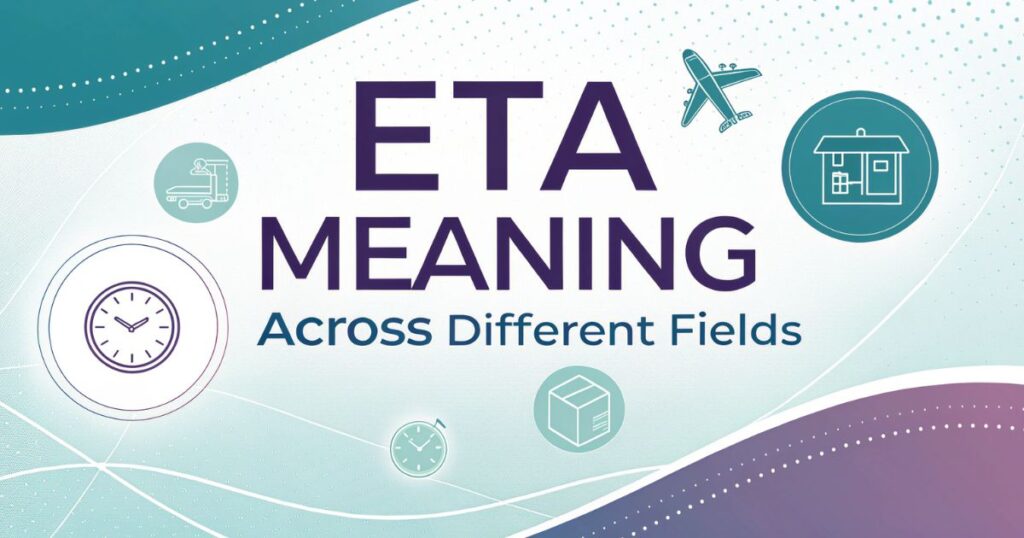You’ve probably checked your phone countless times today, wondering when that delivery will arrive or how long your commute will take.
ETA has become the silent orchestrator of modern life, governing everything from billion-dollar supply chains to your evening dinner plans.
Understanding its true significance transforms how you navigate both professional challenges and personal scheduling chaos.
What is ETA?
Estimated Time of Arrival represents far more than a simple timestamp. This three-letter acronym carries the weight of expectations, planning, and coordination across virtually every industry.
The word “estimated” holds particular importance here. Unlike scheduled times, ETA calculations incorporate real-world variables—traffic patterns, weather conditions, human behavior, and countless unpredictable factors.
ETA differs fundamentally from related terms like ETD (Estimated Time of Departure). While ETD focuses on when something leaves, ETA concentrates on arrival—the moment that truly matters for planning purposes.
Modern ETA systems blend historical data with real-time information. Your GPS doesn’t just know the distance; it analyzes current traffic, construction zones, accident reports, and even typical driver behavior patterns.
ETA Meaning Across Different Fields

Transportation & Logistics Revolution
The shipping industry depends entirely on accurate ETAs. A single container ship’s delayed arrival can cascade through global supply chains, affecting everything from smartphone production to grocery store shelves.
Airlines manage passenger expectations through sophisticated ETA systems. When your flight shows a 45-minute delay, complex algorithms have calculated gate availability, air traffic patterns, and crew scheduling constraints.
Ride-sharing platforms like Uber revolutionized transportation by making ETAs transparent. Before smartphones, you waited indefinitely at taxi stands. Now, you know exactly when your ride arrives—down to the minute.
Ground transportation statistics reveal that 85% of Americans make daily decisions based on ETA information from navigation apps. This dependency has fundamentally altered commuting patterns and urban planning strategies.
Business Communications Excellence
Project management relies heavily on ETA accuracy. Software development teams use sprint planning to estimate feature completion times, directly impacting product launch schedules and market competitiveness.
Customer service departments leverage ETAs to manage expectations. When representatives provide realistic timeframes for issue resolution, customer satisfaction scores increase by an average of 23%.
Manufacturing operations coordinate complex production schedules using ETA data. Assembly lines require precise timing—components must arrive exactly when needed to avoid costly delays or excess inventory.
Technology & Digital Platforms
Software development teams estimate code deployment times, system maintenance windows, and feature release schedules. DevOps practices have elevated ETA accuracy to an art form through continuous integration pipelines.
Data processing systems provide ETAs for large-scale computations. Cloud platforms show users exactly how long their machine learning models will take to train, enabling better resource planning.
Emergency services optimize response times through advanced ETA calculations. Ambulance dispatch systems consider traffic patterns, hospital capacity, and crew locations to save precious minutes—and lives.
Why ETA Importance Cannot Be Overstated
Massive Economic Impact
American businesses lose approximately $87 billion annually from delivery delays and poor time estimation. This staggering figure encompasses missed opportunities, frustrated customers, and operational inefficiencies.
Customer retention rates show direct correlation with ETA accuracy. Companies providing reliable arrival estimates enjoy 34% higher customer loyalty compared to competitors with unpredictable timelines.
Productivity gains from effective time estimation ripple through entire organizations. Teams that master ETA forecasting complete projects 18% faster while maintaining higher quality standards.
Psychological Benefits
Anxiety reduction represents one of ETA’s most underestimated benefits. Uncertainty creates stress; knowing when something will happen allows mental preparation and planning.
Planning efficiency improves dramatically when individuals understand realistic timeframes. You can schedule back-to-back meetings confidently when you know travel times precisely.
Trust building in relationships—both personal and professional—depends on reliable time commitments. People who consistently meet their stated ETAs develop reputations for dependability.
Operational Excellence
Supply chain resilience during disruptions relies on accurate ETA forecasting. The COVID-19 pandemic highlighted how essential these systems are for maintaining commerce and essential services.
Emergency response coordination saves lives through precise timing. Natural disaster relief efforts depend on knowing exactly when resources will reach affected areas.
Quality control in time-sensitive processes requires exact timing. Food safety, pharmaceutical manufacturing, and chemical processing all depend on precise ETA calculations.
The Significance of ETA in Modern Life
Digital Transformation Impact
Real-time tracking has revolutionized consumer expectations. Amazon’s package tracking system processes over 5 billion delivery updates daily, setting new standards for transparency.
AI-powered prediction algorithms continuously improve ETA accuracy. Machine learning systems analyze millions of data points—weather patterns, historical traffic, seasonal variations—to refine estimates.
IoT connectivity enables unprecedented precision. Sensors on delivery trucks, ships, and aircraft provide constant location updates, creating remarkably accurate arrival predictions.
Consumer Behavior Shifts
On-demand economy platforms like DoorDash and Instacart have conditioned consumers to expect precise ETAs. This cultural shift affects purchasing decisions across all industries.
Instant gratification culture demands transparency. Research shows 73% of consumers expect regular delivery updates, and companies failing to provide them lose customers to competitors.
Transparency expectations extend beyond logistics. Patients want to know exactly how long medical appointments will take; students expect professors to estimate assignment grading timeframes.
Crisis Management Applications
COVID-19 pandemic response relied heavily on ETA systems. Vaccine distribution schedules, testing site wait times, and hospital capacity planning all depended on accurate time estimation.
Natural disaster coordination requires precise ETAs for evacuation routes, emergency supplies, and rescue operations. Hurricane tracking systems provide exact landfall times, enabling life-saving preparations.
Infrastructure projects use ETAs to manage community disruption. Road construction, utility maintenance, and public works projects communicate completion timeframes to minimize public inconvenience.
ETA in Communication
Professional Standards
Email etiquette demands realistic ETA communication. Instead of promising immediate responses, professionals provide specific timeframes: “I’ll review this proposal by Thursday morning.”
Meeting management requires buffer time inclusion. Experienced schedulers add 15-20% contingency to all time estimates, accounting for inevitable delays and transitions.
Client relationships benefit from under-promise, over-deliver strategies. Setting conservative ETAs and beating them builds trust more effectively than optimistic promises followed by disappointment.
Digital Communication Tools
Slack and Microsoft Teams integrate status updates showing availability and response ETAs. These features reduce communication friction and manage expectations automatically.
Project management platforms like Asana and Monday.com provide visual ETA tracking. Team members see exactly when dependent tasks will complete, enabling better coordination.
Mobile applications leverage real-time location sharing for precise arrival estimates. WhatsApp’s live location feature has transformed everything from casual meetups to business appointments.
Cross-Cultural Considerations
American punctuality expectations differ significantly from global norms. Understanding these cultural variations prevents miscommunication in international business contexts.
Remote work challenges amplify ETA importance across time zones. Distributed teams rely heavily on clear timeline communication to maintain productivity and collaboration.
Virtual meeting protocols require new ETA standards. Technical setup time, connection testing, and digital tool preparation all factor into modern scheduling requirements.
Common ETA Challenges and Solutions
Accuracy Problems
Traffic variables create the most common ETA disruptions. Construction zones, weather events, and accidents can invalidate even sophisticated algorithmic predictions.
Human factors introduce estimation bias. The “planning fallacy” causes people to consistently underestimate task completion times, leading to unrealistic ETAs.
Technology limitations affect GPS accuracy in urban canyons, tunnels, and areas with poor cellular coverage. These blind spots can significantly impact arrival predictions.
Communication Breakdowns
Information silos prevent real-time ETA updates from reaching relevant stakeholders. Poor communication infrastructure causes delays to cascade unnecessarily.
Stakeholder management becomes complex when multiple parties require different ETA information. Coordinating updates across diverse audiences requires systematic approaches.
Language barriers complicate ETA communication in international contexts. Clear, simple messaging prevents misunderstandings that lead to coordination failures.
Proven Solutions
Buffer time strategies recommend adding 15-20% contingency to all estimates. This approach accounts for unexpected delays while maintaining realistic expectations.
Technology integration through APIs and automated notifications keeps all parties informed without manual intervention. System-to-system communication reduces human error.
Training programs teach estimation skills and communication protocols. Organizations investing in ETA training see measurable improvements in project completion rates.
Industry-Specific ETA Applications
Healthcare Sector Excellence
Emergency response systems calculate ambulance ETAs using real-time traffic data, hospital capacity information, and crew availability. These calculations directly impact patient outcomes.
Patient care coordination relies on appointment scheduling ETAs. Medical facilities use prediction algorithms to minimize wait times while maximizing provider utilization.
Medical supply chains require precise delivery timing for perishable medications, organs for transplant, and critical equipment. Lives depend on accurate ETA forecasting.
E-commerce and Retail
Last-mile delivery represents the final ETA challenge in online shopping. Companies invest billions in logistics networks to provide accurate, customer-friendly arrival windows.
Inventory management uses supplier ETAs to optimize stock levels. Just-in-time inventory systems reduce storage costs while preventing stockouts.
Return processing requires reverse logistics ETAs. Customers want to know exactly when returned items will be processed and refunds issued.
Construction and Manufacturing
Project timelines depend on material delivery ETAs, equipment availability, and labor scheduling. Construction delays cost the US economy over $31 billion annually.
Equipment scheduling coordinates complex machinery across multiple job sites. Mobile cranes, concrete pumps, and specialized tools require precise timing to maintain productivity.
Quality assurance phases need exact timing for inspections, testing, and approvals. Regulatory compliance often depends on meeting specific timeline requirements.
Future of ETA
Artificial Intelligence Integration
Predictive analytics systems analyze vast datasets—weather forecasts, historical patterns, social events—to improve ETA accuracy continuously. These systems learn from every prediction.
Machine learning algorithms identify subtle patterns humans miss. Seasonal shopping trends, local event impacts, and behavioral variations all influence arrival time calculations.
Deep learning models process satellite imagery, social media data, and IoT sensor information to predict disruptions before they occur.
Autonomous Systems Revolution
Self-driving vehicles will revolutionize ETA accuracy through precise speed control and optimal route selection. Autonomous systems eliminate human unpredictability factors.
Drone delivery networks create new ETA paradigms for short-distance shipments. Direct point-to-point flight paths eliminate traditional routing constraints.
Smart city infrastructure coordinates traffic signals, parking availability, and public transportation to optimize system-wide ETAs.
Blockchain and Transparency
Supply chain visibility through immutable blockchain records provides trustworthy ETA information. Every step of product journeys becomes verifiable and transparent.
Smart contracts execute automatically based on ETA achievements. Payments, penalties, and performance bonuses can be tied directly to arrival time accuracy.
Consumer trust increases when delivery commitments become verifiable through distributed ledger technology.
Maximizing ETA Effectiveness
Personal Productivity Mastery
Time blocking requires realistic ETA estimation for every activity. Successful people consistently add buffer time to prevent schedule compression.
Contingency planning means preparing for delays before they occur. Keep backup plans and alternative routes readily available.
Digital tool integration connects calendars, navigation apps, and communication platforms for seamless ETA sharing across your network.
Business Applications
Customer communication should provide proactive updates rather than reactive explanations. Inform clients about delays before they ask.
Team coordination benefits from shared timeline visibility. Project dashboards showing real-time ETAs improve collaboration and planning.
Performance metrics tracking ETA accuracy helps identify improvement opportunities. Measure estimation quality across teams and projects.
Technology Utilization
Mobile applications like Google Maps and Waze provide real-time traffic updates, but combine multiple sources for better accuracy.
Automation platforms like IFTTT and Zapier can trigger ETA notifications across different systems automatically.
Smart notification systems learn your preferences and provide relevant ETA updates without overwhelming you with unnecessary information.
FAQs
What is the ETA meaning?
ETA stands for Estimated Time of Arrival – the predicted time when someone or something will reach a specific destination. It’s calculated using real-time data, historical patterns, and various external factors like traffic or weather.
What is the importance of ETA?
ETA importance spans economic efficiency, stress reduction, and operational coordination. Accurate ETAs save businesses $87 billion annually in the US alone while helping individuals plan better and reduce anxiety about timing uncertainties.
What is the significance of ETA?
ETA significance extends beyond simple time prediction to enable complex supply chains, emergency response coordination, and customer satisfaction management. Modern society depends on ETA accuracy for everything from food delivery to life-saving medical care.
What is the full form of ETA in communication?
In communication contexts, ETA means Estimated Time of Arrival for responses, project completion, or deliverables. It helps set expectations and coordinate team activities by providing realistic timeframes for task completion.
Conclusion
ETA mastery transforms chaos into coordination, uncertainty into confidence, and inefficiency into excellence. Whether you’re managing a global supply chain or simply trying to arrive on time for dinner, understanding and leveraging ETA principles gives you a significant competitive advantage. The future belongs to those who can predict, communicate, and deliver on time—every time.
More Posts
1111 Meaning: Angel Number 1111 and the Idea of Pause
Habibti Meaning: Definition, Common Usage, and Synonyms
Copacetic Meaning, Definition, Common Usage, and Synonyms

Welcome to Brightnis! I am the admin and creator of this platform. I love questioning ideas and exploring different situations. My goal is to encourage critical thinking and help people see things from new perspectives. Join me in discussing thought-provoking topics and finding unique solutions to everyday challenges!
















